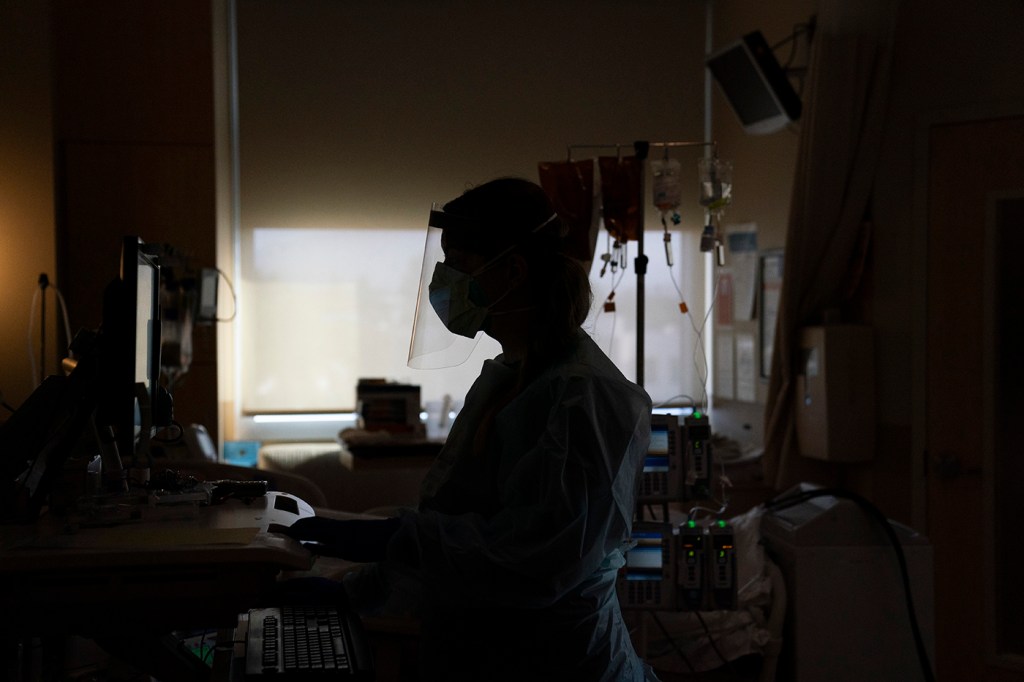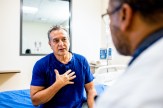Even among healthcare workers, inequities exist in COVID-19 vaccine rollout, new study finds

Healthcare workers experience the same inequities in receiving COVID-19 vaccines as the general public, according to a new study by researchers from Northeastern, Harvard, Northwestern, and Rutgers.

David Lazer, university distinguished professor of political science and computer and information sciences at Northeastern. Photo by Adam Glanzman/Northeastern University
A hypothetical 50-year old white male doctor in the Northeast who earns more than $200,000 a year had a 45 percent chance of being vaccinated, for example, while a 45-year old Black female nursing assistant in the South earning less than $50,000 had only a 6 percent chance, mirroring society as a whole, the survey found.
The gender divide was equally stark, as males in the healthcare industry were twice as likely to be inoculated as women (18 percent vs. 9 percent), mostly because more men are doctors, researchers found. Women, who make up a larger proportion of nurses and home health aides, were considerably more skeptical than men (27 percent to 13 percent) about getting vaccinated.
“Doctors at these hospitals aren’t trying to talk to the nurses and the janitors about why they should be convinced of the safety of vaccines,” explains David Lazer, university distinguished professor of political science and computer and information sciences at Northeastern, and one of the researchers who conducted the study.
Researchers polled nearly 2,000 workers in the healthcare field, a large swath of professions that includes surgeons, lab technicians, nurses, and hospital janitors. Their responses were then compared to a broader demographic of 25,000 people that researchers have been tracking since April.
The healthcare workers, however, were surveyed between Dec. 16 and Jan. 10, right around the time when vaccinations in the United States first began. Many of the first to receive them were nurses.
They and others in the healthcare field made for a good pilot population to make comparisons against because of their diversity, which stacks up well against those who don’t work in the industry, explains Lazer.
And, “they’re the first population that has had the opportunity to be vaccinated,” he says.
In general, the survey found that 21 percent of health professionals were opposed to getting vaccinated, slightly lower than non-healthcare workers (23 percent). Their reasons for not wanting the vaccine were not included in the study.
But when broken down by education level, income, and politics, a wide chasm developed. For example, 29 percent of those in healthcare fields with a high school education or less were opposed to getting inoculated. Those with a bachelor’s or graduate degree, however, were significantly more likely to say they were already vaccinated.
Likewise, just 8 percent of those earning under $50,000 a year were vaccinated, but 23 percent—almost triple—who make $200,000 or more were inoculated. A similar split emerged along political lines, with 30 percent of Republicans saying they would refuse vaccinations, compared to just 13 percent of respondents who identified themselves as Democrats.
Vaccine resistance among healthcare workers has declined over the last few months, which provides some hope for the future vaccination rates among all healthcare workers, Lazer says.
Prior research from Northeastern, Harvard, Northwestern, and Rutgers shows that the most convincing messengers to reduce vaccine doubts are doctors and scientists.
“Healthcare providers are thus much better positioned than most institutions to develop science and health communication strategies to address vaccine hesitancy and resistance,” researchers wrote in the current study.
Inequities, however, remain a concern, adds Lazer.
“If this is a problem among healthcare workers, it’s going to be a problem in our society as a whole,” he says.
Communication and outreach strategies for skeptical populations are important because of their vulnerability, Lazer points out.
“We definitely want to get all the shots in arms as much as possible,” he says.
President Biden said last week that the United States will have enough coronavirus vaccines for 300 million Americans. Moderna and Pfizer will deliver a total of 200 million vaccines by the end of July, rather than the end of the summer, he said. The companies also will deliver 100 million expected doses by the end of May, rather than the end of June.
Lazer predicts that by April or May, the nation may face a situation where there are more doses than willing arms because of reluctance.
“There will be people who are willing but inaccessible and then there are going to be a lot of people who are reluctant and need to be convinced,” he says.
Lazer said that the decision by Massachusetts Gov. Charlie Baker to shift doses away from hospitals and other primary care providers to mass vaccination sites such as Fenway Park has a potentially serious downside.
“These sites are great for getting lots of shots in arms, but they’re not great at convincing people to get vaccinated, and they will be difficult for many vulnerable people to get to,” Lazer says.
For media inquiries, please contact media@northeastern.edu.





